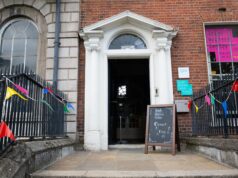By Mary McCarthy
On the lookout for exciting activities this summer that will appeal to children and not bore the teeth off the accompanying adults? Well, have you been to Marsh’s library in Dublin City centre which opened 300 years ago?
Ireland’s oldest public library works hard to appeal to both adults and children by presenting its fascinating history in an accessible manner. The library had 30,000 visitors last year, of which 6,500 were children.
The numbers were up because of more outreach with primary schools, but also because more children wanted to visit after reading the “The Lost Library Book” which tells the tale of an ancient book found in a junk shop and returned to Marsh’s library 100 years after it went missing.
The author Amanda Bell has run a lot of workshops in schools and libraries since the book was published in 2017.
Lost medical book was 500 years old
The ‘Lost Library Book’ tells the true story of how an Irish barrister, Patrick Gageby, stumbled on a dusty book in a junk shop which turned out to be a really important medical encyclopedia published around 500 years ago.
The Galeni Librorum was one of a five volume study and had been with the library since it opened in 1707. Gageby returned the valuable book after he spotted the Marsh’s library stamp on it. Written by Galen of Pergamum, doctor to Roman Emperor Marcus Aurelius, in the 1st century AD, it had been preserved in handwritten form until the 1500’s when it was printed in Greek.
Before being donated to Marsh’s the volumes were owned and updated by hand by the 17th century English doctor Theodore Gulston. The book had only been discovered missing a few months before Gageby returned it when a Berlin scholar had come to Marsh’s to study Dr Gulston’s inscriptions. The returned book adds to the library’s rich lore and Library keeper Jason McElligott said visitors regularly come wanting to see Marsh’s after reading the book.
“Only last Wednesday we had a woman who brought two young pre-school children to the library and told them on the way in that this was the library they had read about. That happens a few times a month, he said. McElligott said sales of the book were steady with the majority being American or Canadian parents or grandparents looking for a presents to bring home.
“I think North Americans are used to a genre of books about libraries for kids, like ‘Bats in the Library’ and ‘Thomas Jefferson Builds a Library’. It seems to be a thing in the States and Canada to have books for kids about libraries and museums for sale in libraries and museums”, he said.
Children fascinated with the past
The Lost Library Book is a fun way to educate children about the history of printing and the value of old books to show us how people used to live.
Author Amanda Bell said she has been doing a lot of workshops in schools and libraries and the kids were so enthusiastic about visiting Marsh’s.
“The book has an impact in two ways. The first is in that when kids attend one of my workshops, read it in school or at the local library they will want to visit Marsh’s. Secondly, if foreign visitors buy it in Marsh’s it spreads the word about the Library abroad”, she said.
Pinched books
Bell’s book takes a kind view suggesting the book fell behind a bed, but the reality is Marsh’s has never been a lending library and a significant medical text such as the Galen Librorum would have been locked away.
Although the book has a happy ending, unfortunately over the years, many books have wandered off, despite the introduction of reading cages in the 18th century.
“A total of 1200 stolen from the library, about 6 percent of the entire collection”, said Dr McElligott.
Visitors often ask about most valuable books and McElligott says there is not a strong correlation between the rarity of an item and its monetary value at sale or auction.
He said many of the books that are fetshiized by collectors survive in multiple copies but it’s the small inexpensive items produced for the mass market and often read to death that are really rare.
“These sole surviving copies are the real treasures. Fragments of human history and culture which teether on the edge of oblivion. They warn us about the fragility of the historical record and provide a sense of how much produced during the first information revolution must have been lost entirely”, said Dr Elligott.
Marsh’s holds the sole surviving copy in the world of 387 books and pamphlets and this figure is likely to increase as more research is done.
Marsh’s Library has hardly changed since it opened over 300 years ago with the founding collections intact and shelved according to the classification system designed by the first librarians. There are 80 books published before 1501 but the vast majority were printed during the sixteenth and seventeenth centuries.
The Lost Library Book is available for sale in Marsh’s Library, some small bookshops and online from the publisher The Onslaught Press.
If you are looking for some day trips this summer:
- Marsh’s Library is 3 euro entry for adults and children under 16 go free. The Library, which is right beside St Patrick’s Cathedral, is open 9.30 – 5pm and closed Sunday and Tuesday.
- It has a lego figure hunt and has a special comic for children that tells the history of the Library and talks about its many famous visitors such as Bram Stoker, Jonathan Swift and James Joyce.
Mary McCarthy
Mary McCarthy is a freelance journalist writing for a number of publications. She is an avid reader and an iron-willed book club administrator. @maryknowsbees












